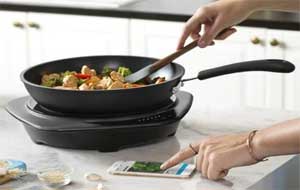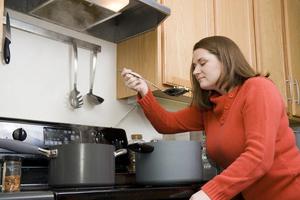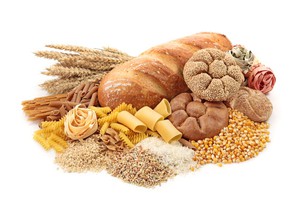Here are 4 cooking mistakes you make that make you gain weight
![]()
 Cooking at home sounds like a much healthier option than eating out, doesn’t it?
Cooking at home sounds like a much healthier option than eating out, doesn’t it?
A recent study showed that middle-aged women who spent more time cooking at home were more likely to prevent metabolic syndrome. This study was based more on the concept of cooking at home than on the wholesomeness of cooked meals.
In other words, the researchers emphasized that cooking at home is always a good opportunity to eat healthily.
Here are 4 cooking mistakes that unknowingly make you gain weight.
You nibble while you cook
 Among the cooking mistakes that make you gain weight is not realizing how much you’re eating while you’re preparing your meal.
Among the cooking mistakes that make you gain weight is not realizing how much you’re eating while you’re preparing your meal.
It’s easy to down a glass or two of wine, ingest cubes of cheese or swallow other foods without realizing it.
This thoughtless, unconscious nibbling can easily add a few extra 300 or 400 calories to your diet.
– The solution:
The obvious solution is that you should stop snacking.
But if you can’t help yourself while you’re cooking, then consider eating low-calorie raw vegetables like sliced bell bell pepper or cucumber.
To compensate, you can also reduce certain ingredients, starting with the amount of oil you usually use.
Overloading your dishes with (healthy) carbohydrates
 Many health-conscious people have managed to give up white bread and pasta in favor of healthy starches such as quinoa, wild rice or lentils.
Many health-conscious people have managed to give up white bread and pasta in favor of healthy starches such as quinoa, wild rice or lentils.
This is undoubtedly a very good decision, provided you don’t fall into the trap of eating excess portions of these healthy foods.
Because if you do, your weight loss efforts will be sabotaged!
As you should know, it’s not advisable to completely eliminate carbohydrates from your diet, but rather to eat quantities proportional to your energy needs.
For example, if you spend a lot of time sitting down, your starch portion should be between half a cup and a cup.
This amount is given for information only and can be revised upwards if you’re young and physically active, and downwards if you’re older and less active.
This portion should be combined where appropriate with a generous portion of vegetables with lean protein and a little lean fat.
– Solution:
The trick is to reverse the roles.
The vegetable portion of your dish should be the main attraction, while the starch portion should be an accessory or complement.
You use (a lot of) cheese
 Many of us use cheese (not to say too much cheese) in our cooking, and it’s almost unthinkable to give it up.
Many of us use cheese (not to say too much cheese) in our cooking, and it’s almost unthinkable to give it up.
But we also need to be aware that cheese is a direct source of extra calories, which are stored as fat.
Just consider that a pack of cheddar contains around 4 times more calories and 9 times more fat than a skinless chicken breast.
Sure, it’s a source of protein, but it’s also a considerable source of fat.
– The solution:
If you don’t want to give up cheese altogether, then think of it as a condiment, and use it sparingly.
You indulge in dessert (and too often)
We all have that irresistible urge for a little something sweet after dinner.
But a cookie can easily turn into three, and a serving of ice cream can easily become a whole cup.
The temptation is too strong, and our resistance is continually challenged!
– The solution :
The desire for sweets is often fuelled by emotions, such as the need for reward or comfort.
It’s therefore advisable to focus more on the feelings (which are the source) than on the food itself.
If you can find another, healthier way to satisfy your emotional needs, this desire for sweets will naturally diminish until it disappears altogether.
If that doesn’t work, you can opt for a few squares of dark chocolate or simply make room for that occasional dessert (and of course its extra calories) by reducing the amount of carbohydrates and fats in your meal.
It’s all about balance, remember!



